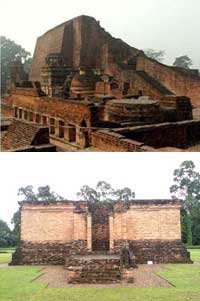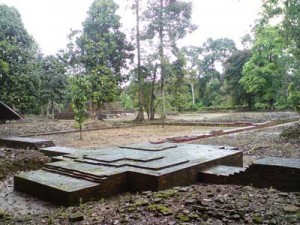
While there are many similarities between the complex of Muarajambi and Nalanda, not many comparative studies have been made between the two, let us thus consider the similarities.
As was the case with Nalanda, which served as an important seat of learning in India at the time, there is a possibility that in Indonesia during the same period of time, there existed a great centre of learning that was on par with the best learning centres in the world. The development of Indian institutions, especially Sanghrama Nalanda, might have played a crucial role in and influenced the development of Muarajambi complex as an education centre or university.
Archaelogical Evidences
The monasteries in Nalanda were built one by one, either in a row or next to each other, during different time periods and it took an approximate 110 years to complete the construction of the entire complex. Temple buildings in Muarajambi region were also built in a row or next to each other. As in the case of Nalanda, the buildings in Muarajambi region were believed to have been built in different periods of time over many years.
Buildings in Muarajambi region were located in a compound, close to one another and basically forming a row. Almost all buildings in Muarajambi region were square-shaped of various sizes in area, and surrounded by around six-meter high wall. As described by I-Tsing, when he stayed in Fo-Shih: “In the walled city of Fo-Shih, (lived) Buddhist monks number more than 1,000, whose minds are bent on learning and good practice”. There were at least six man-made canals that connected one building to another. Until a few years ago, the canals were still utilized by local people who traveled in them using traditional boats.
The design and layout of the compound, featuring the placement of buildings in a row, logistically makes perfect sense. Since the routine of daily life was mainly divided between study and religious rites, the temples were built close to the caityas (shrines specially designated for conducting prayers and usually also for storing relics). Candi Astano, for instance, was believed to be a caitya, as the term ‘astano’ means ‘tomb’. While all the buildings in Muarajambi region formed a row, the distance between one building to another was not as close as in Nalanda. This was probably there were canals to connect the buildings.
Nalanda Mahavihara was built in the traditional design. The courtyards were square, surrounded flanked on all sides with running verandahs. Some of these courtyards and their verandahs, with rows of supporting wooden pillars (of which presently only the sockets show), and the monks’ quarters behind, can still be seen among the ruins. Similar patterns were related to ruins in Muarajambi region.
In some of these courtyards, there were shrines with a podium in its front on a lower level. It was in these courtyards, it seems, that lectures and discourses used to be delivered – the preceptor standing or sitting on the podium with a pulpit in front of him to spread his manuscripts upon, while the students sat round him.
It was believed that almost all classes and other activities were conducted within the walled area, in the open yards that were paved with bricks. The ruins of wall foundation, yards and paving can still be seen in the Muarajambi region.
 Wall foundation, yards and paving in Muarajambi region
Wall foundation, yards and paving in Muarajambi region
The Similarity on Subject of Studies According to Pilgrims’ Writings
I-Tsing wrote that “They (the monks in Fo-Shih) investigate and study all the subjects that exist just as in Middle Kingdom (Madhya-desa, India)”. This indicates that subjects such a logic, grammar and philology, medicine, arts, as well as metaphysics and philosophy was taught in Fo-Shih at the time was at least on par or even exceeded in terms of breadth as compared to modern-day universities that subsequently arose in the West.
As elaborated above, Nalanda University was operated based on the Mahayana world view, although other philosophical schools of thought were also taught. Sanskrit was the language applied as the teaching medium. The Talang Tuwo inscription (684) also indicates that in the 7th century, Srivijaya followed the Mahayana school of thought and I-Tsing also described that he had studied Sanskrit grammar in Fo-Shih.
Srivijaya and India’s Relationships in the Fields of Education, Trades, Religion and Politics
As previously mentioned, there existed strong bond between Srivijaya and India at the time. This fact is mentioned in at least two inscriptions:
- The Nalanda Copperplate (860) was issued by a king of Bengal named Devapaladeva. The copperplate constitutes a request from a king of Suvarnadvipa named Balaputradeva to build a monastery in Nalanda, where king Devapaladeva offered five villages to maintain the monastery and support the students.
- The Larger and Smaller Leiden Grants inscriptions (1015) tell of a king of Suvarnadvipa, Sri Maravijayatunggavarman who built a monastery at Nagapattana in South India in the name of his father Cudamanivarman. The Chola king Rajaraja, in circa 1005 CE granted a village for the upkeep of this monastery.
Therefore, based in the writings of pilgrims, especially I-Tsing, as well as archeological remains, inscriptions and records of other pilgrims, it is very probable that in Srivijaya, especially in the Muarajambi region, there was a major education center, a university to the order of Nalanda University in India during the same period.
It is therefore advisable that one should not only rely on physical evidences that are certainly difficult to find after so many centuries have passed, but to assume an open mind to explore the possibilities, as it is only with this kind of attitude and approach that will enable us to uncover the new aspects that have never been revealed.
 Bahasa
Bahasa
 October 24th, 2010
October 24th, 2010  SUDIMUJA
SUDIMUJA  Posted in
Posted in  Tags:
Tags: